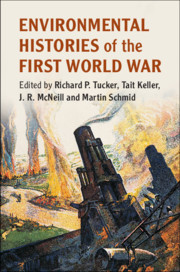106 results
The Texas Community-Engagement Research Alliance Against COVID-19 in Disproportionately Affected Communities (TX CEAL) Consortium
-
- Journal:
- Journal of Clinical and Translational Science / Volume 6 / Issue 1 / 2022
- Published online by Cambridge University Press:
- 25 April 2022, e64
-
- Article
-
- You have access
- Open access
- HTML
- Export citation
Tables
-
- Book:
- Environmental Histories of the First World War
- Published online:
- 16 August 2018
- Print publication:
- 23 August 2018, pp ix-ix
-
- Chapter
- Export citation
Part I - Europe and North America
-
- Book:
- Environmental Histories of the First World War
- Published online:
- 16 August 2018
- Print publication:
- 23 August 2018, pp 17-96
-
- Chapter
- Export citation
Copyright page
-
- Book:
- Environmental Histories of the First World War
- Published online:
- 16 August 2018
- Print publication:
- 23 August 2018, pp iv-iv
-
- Chapter
- Export citation
Contributors
-
- Book:
- Environmental Histories of the First World War
- Published online:
- 16 August 2018
- Print publication:
- 23 August 2018, pp x-xi
-
- Chapter
- Export citation
Part IV - The Long Aftermath
-
- Book:
- Environmental Histories of the First World War
- Published online:
- 16 August 2018
- Print publication:
- 23 August 2018, pp 255-295
-
- Chapter
- Export citation
Part II - War’s Global Reach
-
- Book:
- Environmental Histories of the First World War
- Published online:
- 16 August 2018
- Print publication:
- 23 August 2018, pp 97-172
-
- Chapter
- Export citation
Index
-
- Book:
- Environmental Histories of the First World War
- Published online:
- 16 August 2018
- Print publication:
- 23 August 2018, pp 296-312
-
- Chapter
- Export citation
Part III - The Middle East and Africa
-
- Book:
- Environmental Histories of the First World War
- Published online:
- 16 August 2018
- Print publication:
- 23 August 2018, pp 173-254
-
- Chapter
- Export citation
Contents
-
- Book:
- Environmental Histories of the First World War
- Published online:
- 16 August 2018
- Print publication:
- 23 August 2018, pp v-vi
-
- Chapter
- Export citation
Figures
-
- Book:
- Environmental Histories of the First World War
- Published online:
- 16 August 2018
- Print publication:
- 23 August 2018, pp vii-viii
-
- Chapter
- Export citation
Acknowledgments
-
- Book:
- Environmental Histories of the First World War
- Published online:
- 16 August 2018
- Print publication:
- 23 August 2018, pp xii-xii
-
- Chapter
- Export citation

Environmental Histories of the First World War
-
- Published online:
- 16 August 2018
- Print publication:
- 23 August 2018
Tobacco smoking is associated with psychotic experiences in the general population of South London
-
- Journal:
- Psychological Medicine / Volume 48 / Issue 1 / January 2018
- Published online by Cambridge University Press:
- 28 June 2017, pp. 123-131
-
- Article
- Export citation
Michael Zeheter, Epidemics, Empire, and Environments: Cholera in Madras and Quebec City, 1818–1910 (Pittsburgh: University of Pittsburgh Press, 2015), pp. Ix + 325, Maps, index.
-
- Journal:
- Medical History / Volume 60 / Issue 4 / October 2016
- Published online by Cambridge University Press:
- 15 September 2016, pp. 603-605
-
- Article
-
- You have access
- HTML
- Export citation
P3 In vivo measurement of toxic elements using X-ray fluorescence analysis
-
- Journal:
- Powder Diffraction / Volume 21 / Issue 2 / June 2006
- Published online by Cambridge University Press:
- 20 May 2016, p. 169
-
- Article
- Export citation
Copyright page
-
- Book:
- The Cambridge World History
- Published online:
- 05 May 2015
- Print publication:
- 30 April 2015, pp vi-vi
-
- Chapter
- Export citation
Contributors
-
- Book:
- The Cambridge World History
- Published online:
- 05 May 2015
- Print publication:
- 30 April 2015, pp xiv-xiv
-
- Chapter
- Export citation
Index
-
- Book:
- The Cambridge World History
- Published online:
- 05 May 2015
- Print publication:
- 30 April 2015, pp 632-656
-
- Chapter
- Export citation
Maps
-
- Book:
- The Cambridge World History
- Published online:
- 05 May 2015
- Print publication:
- 30 April 2015, pp xii-xii
-
- Chapter
- Export citation



